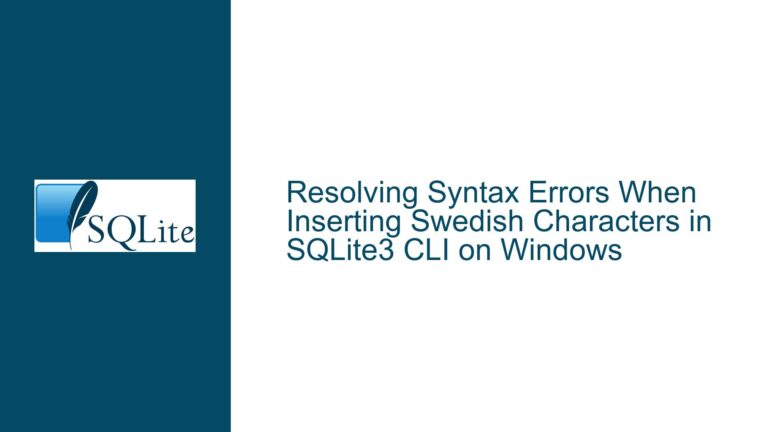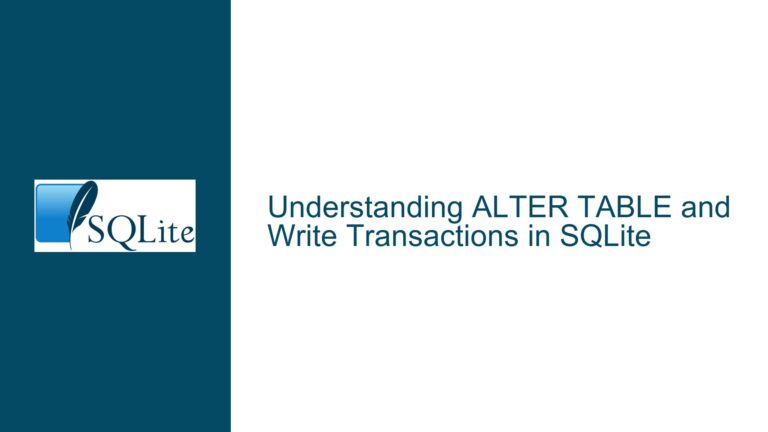Transaction Rollback Behavior: RAISE(ABORT) vs RAISE(FAIL) in SQLite Triggers
Transaction Rollback Scope and Multi-Row Operation Outcomes
The distinction between RAISE(ABORT) and RAISE(FAIL) in SQLite triggers revolves around their impact on transaction atomicity during multi-row operations. When a DELETE, INSERT, or UPDATE statement affects multiple rows, the behavior of these two error-raising mechanisms diverges significantly. RAISE(ABORT) ensures full transaction rollback to the state preceding the entire operation, while RAISE(FAIL) permits partial persistence of changes made prior to the error point. This fundamental difference stems from SQLite’s approach to statement execution and transaction boundary management.
Every SQL statement in SQLite operates as an atomic transaction by default, meaning the entire statement either completes successfully or fails without modifying the database. However, when triggers containing RAISE commands intervene in this process, they alter the default atomicity guarantees. Consider a DELETE operation targeting 1,000 rows where a BEFORE DELETE trigger contains RAISE(ABORT). If the trigger fires on row 500, RAISE(ABORT) rolls back all preceding 499 deletions, restoring the database to its pre-statement state. Contrast this with RAISE(FAIL), which would preserve the first 499 deletions while halting further processing, leaving the database in a partially modified state.
The practical implications manifest in data integrity scenarios. Financial systems requiring all-or-nothing updates must use RAISE(ABORT) to prevent partial balance adjustments. Conversely, RAISE(FAIL) might suit audit logging implementations where partial progress preservation proves acceptable. Developers must recognize that trigger-induced exceptions bypass SQLite’s default statement-level atomicity when using RAISE(FAIL), creating potential data consistency gaps. This behavior becomes particularly critical in bulk operations where error frequency increases with dataset size.
Testing methodologies should emphasize multi-row operations to surface these behavioral differences. Executing sample scripts with controlled error injection points reveals how RAISE(ABORT) maintains database invariants while RAISE(FAIL) permits invariant violation through partial execution. Performance considerations also emerge—RAISE(ABORT) incurs rollback overhead proportional to operation progress, whereas RAISE(FAIL) minimizes computational waste by preserving completed work at the cost of potential inconsistency.
Trigger Execution Contexts and Error Propagation Mechanisms
The divergence between RAISE(ABORT) and RAISE(FAIL) originates from SQLite’s layered transaction architecture and trigger execution lifecycle. When a triggering statement modifies multiple rows, SQLite implicitly creates a statement-level savepoint. RAISE(ABORT) triggers a rollback to this savepoint, unwinding all changes made by the current statement. RAISE(FAIL) terminates statement execution without rollback, leaving prior row modifications intact while aborting subsequent processing.
This behavior stems from SQLite’s error handling hierarchy. The database engine processes each row operation sequentially within a statement, invoking relevant triggers at each step. When a trigger raises an error, the engine must decide whether to unwind the current statement’s changes (ABORT) or preserve them (FAIL). Under RAISE(ABORT), SQLite throws a SQLITE_CONSTRAINT error and rolls back the statement’s savepoint. RAISE(FAIL) generates a SQLITE_CONSTRAINT error but retains the statement’s progress, equivalent to reaching an implicit ROLLBACK TO SAVEPOINT for ABORT versus simple execution termination for FAIL.
The interaction with explicit transactions compounds these effects. Consider a BEGIN…COMMIT block containing multiple statements. RAISE(ABORT) within a trigger only rolls back the current statement’s changes, leaving prior statements in the transaction intact. RAISE(FAIL) behaves identically in this regard—both error types operate at the statement level rather than the transaction level. This nuance frequently causes confusion, as developers might expect RAISE(ABORT) to roll back entire transactions. Proper error handling requires wrapping individual statements in SAVEPOINT blocks when granular rollback control proves necessary.
Constraint enforcement timing further differentiates these commands. RAISE(ABORT) in triggers mimics SQLite’s native constraint violation behavior, which automatically rolls back the entire statement. RAISE(FAIL) creates artificial constraint violations that bypass this automatic rollback, producing hybrid states where some constraints appear violated until subsequent repairs. Developers combining trigger-based constraints with native SQLite constraints (UNIQUE, CHECK, etc.) must account for these differing rollback scopes to maintain expected constraint enforcement behavior.
Implementing Robust Error Handling Strategies with RAISE Semantics
Selecting between RAISE(ABORT) and RAISE(FAIL) requires analyzing operational idempotency requirements and recovery workflows. RAISE(ABORT) suits operations demanding full rollback on any error—typical in financial transactions or inventory management systems. RAISE(FAIL) benefits scenarios where partial progress proves acceptable or recoverable, such as batch processing with error logging and retry mechanisms.
Implementation patterns should include:
Atomic Operations: Wrap critical multi-statement operations in SAVEPOINT blocks when using RAISE(FAIL) to enable partial recovery. This allows rolling back only the failed sub-operation while preserving prior successes within the transaction.
Error Diagnostics: Combine RAISE(FAIL) with error message propagation to implement detailed error logging. Capture failed row identifiers in companion tables before raising the error, enabling post-failure analysis without full rollback.
Constraint Layering: Use RAISE(ABORT) in triggers that enforce cross-row consistency constraints, mirroring native SQLite constraint behavior. Reserve RAISE(FAIL) for non-critical validations where manual intervention suffices.
Testing frameworks must validate both single-row and multi-row scenarios. For RAISE(ABORT), confirm that database state remains unchanged after any error occurrence. For RAISE(FAIL), verify that recoverable error states contain sufficient diagnostic data and permit clean continuation. Stress-test with concurrent transactions to ensure isolation levels remain consistent with application requirements.
Debugging techniques include:
- PRAGMA integrity_check: Run after RAISE(FAIL) scenarios to detect lingering constraint violations
- Change Tracing: Use SQLite’s update hooks to log all modifications during trigger execution
- Nested Transaction Visualization: Map savepoint hierarchies with recursive trigger executions
Migration strategies between ABORT and FAIL require careful analysis of existing data dependencies. Convert RAISE(FAIL) to RAISE(ABORT) only after verifying full operation idempotency. Reverse migrations demand implementing compensating transactions for partial failure states. Always couple such changes with comprehensive regression tests covering multi-row operation edge cases.
Performance optimization considerations include benchmarking rollback costs for large operations under RAISE(ABORT) versus the potential lock contention from repeated RAISE(FAIL) recovery attempts. Indexing strategies may require adjustment based on error frequency—frequent RAISE(ABORT) scenarios benefit from indexes that surface errors early in statement execution, minimizing rollback overhead.






